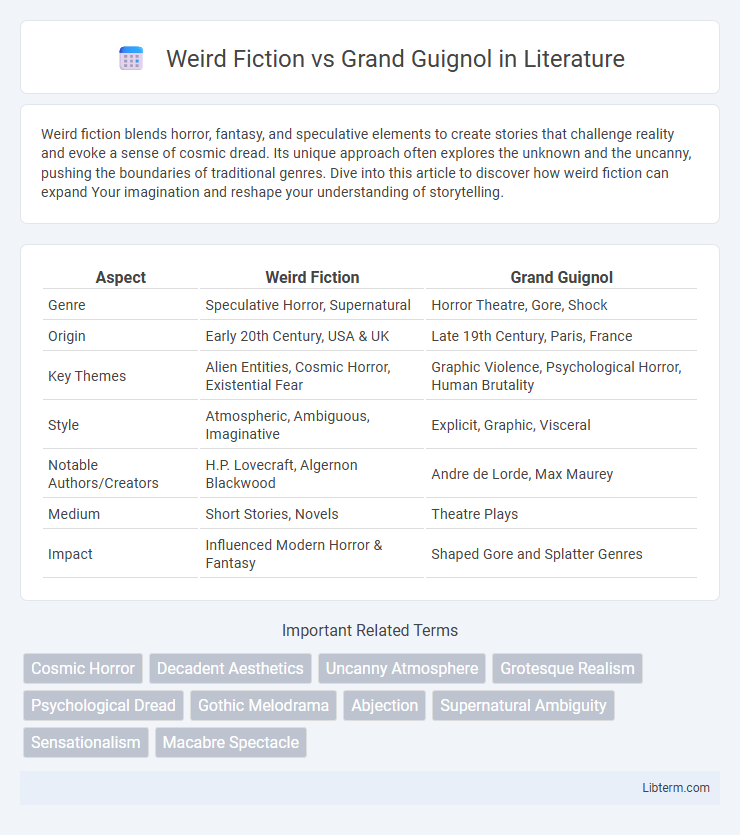Weird fiction blends horror, fantasy, and speculative elements to create stories that challenge reality and evoke a sense of cosmic dread. Its unique approach often explores the unknown and the uncanny, pushing the boundaries of traditional genres. Dive into this article to discover how weird fiction can expand Your imagination and reshape your understanding of storytelling.
Table of Comparison
| Aspect | Weird Fiction | Grand Guignol |
|---|---|---|
| Genre | Speculative Horror, Supernatural | Horror Theatre, Gore, Shock |
| Origin | Early 20th Century, USA & UK | Late 19th Century, Paris, France |
| Key Themes | Alien Entities, Cosmic Horror, Existential Fear | Graphic Violence, Psychological Horror, Human Brutality |
| Style | Atmospheric, Ambiguous, Imaginative | Explicit, Graphic, Visceral |
| Notable Authors/Creators | H.P. Lovecraft, Algernon Blackwood | Andre de Lorde, Max Maurey |
| Medium | Short Stories, Novels | Theatre Plays |
| Impact | Influenced Modern Horror & Fantasy | Shaped Gore and Splatter Genres |
Defining Weird Fiction: Elements and Origins
Weird Fiction, emerging in the early 20th century through authors like H.P. Lovecraft and Clark Ashton Smith, blends horror, fantasy, and speculative fiction to explore cosmic dread and the unknown. Key elements include the presence of indescribable entities, a sense of existential insignificance, and the breakdown of reality, distinct from the theatrical gore and shock tactics typical of Grand Guignol. While Grand Guignol focuses on graphic, visceral horror in live performances, Weird Fiction delves into psychological terror and surreal, otherworldly atmospheres through literature.
The Grand Guignol: History and Distinctive Features
The Grand Guignol, established in Paris in 1897, specialized in theatrical horror characterized by graphic, shocking content and realistic special effects, aiming to provoke visceral fear and revulsion. Unlike Weird Fiction, which explores cosmic horror and the supernatural through literature, Grand Guignol's distinctive feature lies in its live performances emphasizing grotesque violence and macabre themes. This unique blend of theatrical artistry and explicit gore set Grand Guignol apart as a pioneering influence on modern horror cinema and stage productions.
Core Themes: The Uncanny versus the Grotesque
Weird Fiction explores the uncanny through themes of cosmic horror, existential dread, and the unknown lurking beyond human comprehension, emphasizing subtle, psychological terror. Grand Guignol centers on the grotesque, highlighting visceral, graphic violence and macabre spectacle designed to shock and horrify audiences with explicit physical horror. The core thematic divergence lies in Weird Fiction's emphasis on unsettling ambiguity and metaphysical terror contrasted with Grand Guignol's focus on tangible, exaggerated bodily horror.
Atmosphere: Cosmic Dread vs Sensational Horror
Weird Fiction cultivates an atmosphere of cosmic dread, emphasizing the insignificance of humanity in an uncaring universe filled with unknowable entities and existential terror. Grand Guignol, by contrast, relies on sensational horror, delivering visceral shocks through graphic violence and emotional intensity designed to provoke immediate, intense reactions. The former evokes a lingering psychological unease rooted in the unknown, while the latter targets the audience's senses with explicit and theatrical gore.
Character Archetypes in Weird Fiction and Grand Guignol
Weird Fiction often features archetypes such as the unassuming scholar, the alien or cosmic entity, and the haunted or cursed individual confronting incomprehensible horrors, emphasizing psychological and existential terror. Grand Guignol characters are typically exaggerated figures like the mad doctor, the innocent victim, and the sadistic murderer, designed to provoke visceral shock and gore-driven fear. Both genres rely on distinct archetypes that serve their narrative goals: Weird Fiction explores the uncanny and unknown through ambiguous protagonists, while Grand Guignol demands overt, theatrical characters to elicit immediate emotional reactions.
Narrative Structure: Disorientation and Shock Value
Weird Fiction employs disorientation through fragmented narratives and ambiguous realities, creating an unsettling atmosphere that challenges readers' perceptions. In contrast, Grand Guignol relies on a straightforward, linear structure to build tension that culminates in intense shock value and graphic climaxes. Both genres manipulate narrative flow to evoke psychological disturbance, though Weird Fiction emphasizes cognitive unease while Grand Guignol focuses on visceral horror.
Violence and Taboo: Approaches to Fear
Weird Fiction evokes fear through supernatural elements and cosmic horror, often exploring existential dread and the unknown, where violence is implied rather than explicit. Grand Guignol relies on graphic, theatrical depictions of physical violence and grotesque imagery, directly confronting audiences with taboo subjects like murder, mutilation, and madness. Both approaches tap into deep-seated fears but Weird Fiction focuses on psychological terror while Grand Guignol emphasizes visceral shock.
Legacy and Influence on Modern Horror
Weird Fiction reshaped modern horror by blending cosmic dread with surreal, otherworldly elements that challenge human understanding, influencing authors like H.P. Lovecraft and Stephen King. Grand Guignol's legacy lies in its pioneering use of theatrical gore and psychological terror, which laid the groundwork for modern slasher and body horror films. Together, these genres expanded horror's thematic range, inspiring contemporary creators to explore both the unseen horrors of the mind and explicit, visceral fear.
Key Works and Iconic Authors
Weird Fiction is epitomized by H.P. Lovecraft's "The Call of Cthulhu" and Clark Ashton Smith's surreal tales that blend cosmic horror with speculative fiction elements. Grand Guignol is best known for plays by Andre de Lorde, whose graphic murder mysteries and macabre storytelling captivated early 20th-century Parisian audiences. Both genres explore horror through distinct mediums: Weird Fiction through literature's imaginative narratives and Grand Guignol through visceral stage performances emphasizing grotesque spectacle.
Weird Fiction vs Grand Guignol: Lasting Cultural Impact
Weird Fiction and Grand Guignol have each left distinct marks on cultural history, shaping horror and macabre narrative forms. Weird Fiction is noted for its influence on modern speculative fiction, contributing to the development of cosmic horror and inspiring authors like H.P. Lovecraft and contemporary writers in the genre. Grand Guignol's legacy lies in its pioneering of graphic theatrical horror, directly impacting horror cinema and live performance aesthetics with its shock value and visceral storytelling techniques.
Weird Fiction Infographic

 libterm.com
libterm.com